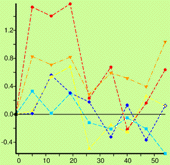| |
 |
 | '
Statistical data-analysis and its interpretation
ECOSTAT offers a complete analysis of your (experimental) data.
For this analysis we use a wide range of statistical techniques such as multiple comparison methods, multi-variate analysis, Monte Carlo simulation techniques, parameter estimation and model comparison.
We also assist you in interpreting the results of our statistical analysis and offers assistance in interpreting the results of other data analyses.
ECOSTAT can also offer you a critical evaluation of a completed data-analysis.
In most cases we will use existing mathemathical models for parameter estimation. We can, however, also develop a model fine-tuned to your biological objectives. ECOSTAT can advice you on the applicability of the model and can analyse the sensitivity of the model to changes in the parameter values and model assumptions using (Monte Carlo) simulation techniques.
Some examples of ECOSTAT's experience

- The analysis of ecological data on species densities in marine sediments
-
The use of statistics for all kind of laboratory ecotoxicological bioassays (with the crustacean Corophium, the sea-urchin Echinocardium, the rotifer Brachionus and larvae of the oyster Crassostrea, among others).
- The analysis of histopathological data in ecotoxicological studies with fish.
- Estimating the environmental distribution of a chemical's concentration from a data set containing many samples with concentration below the detection limit.
- The evaluation of a probabilistic model to set environmental standards for PCBs based on ecotoxicological laboratory data and the PCB partition coefficients

- The analysis of toxicological field and mesocosm studies.
- Estimating the half-life of a chemical and its main metabolite in soil using a first order kinetic model.
For questions on the fate and effect of chemicals, and especially pesticides, in soil and water, ECOSTAT often cooperates with
EPP Consultancy of Dr. J.W. Vonk.
- The EC50 for bioluminescence from Microtox experiments with sediments is estimated using a model correcting for the fact that with increasing sediment concentration more bacteria will bind to the
sediment so that their bioluminescence can no longer be measured. The model was developed by ECOSTAT.
This reseach was sponsored by the Netherlands National Institute for
Coastal and Marine Management (RIKZ) of the Netherlands Ministry of Transport, Public Works and Water Management.
A user version of the model to estimate this EC50 can be downloaded from
website van het RIKZ. On this site you can find it using the search strings "korrelgrootte" or "microtox". (This site is in Dutch.)
|
|
|